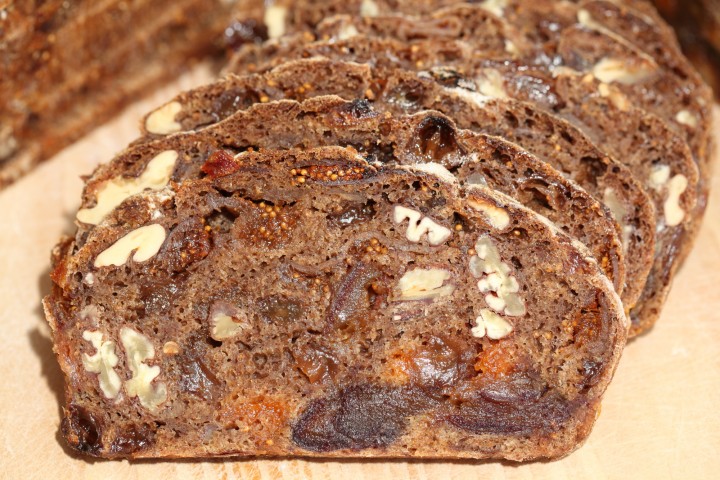
Insane amount of fruit and nuts loaf. Divine with cheese!
You could call this our version of a ‘kletzenbrot’ (kletzenbrood) but without the ‘kletzen’. Kletzen is the Austrian word for a type of dried pear. But this bread will be great with any type of dried fruit you love. Recently we did manage to find some dried pears, so we will be using them for a version of this loaf soon too.
My father has now officially stated that he likes this bread better than pie. I can understand why, it has its sweetness, but the taste is much more complex, with the rye and nuts and spices. Sliced thinly and paired with good cheese it is a very (full)filling thing to eat, especially during these winter months.
We can highly recommend making it for a festive occasion or in the weeks leading up to Christmas. You can make a few loaves in advance, slice them thinly and store in your freezer, it will keep for many weeks.
Happy baking!
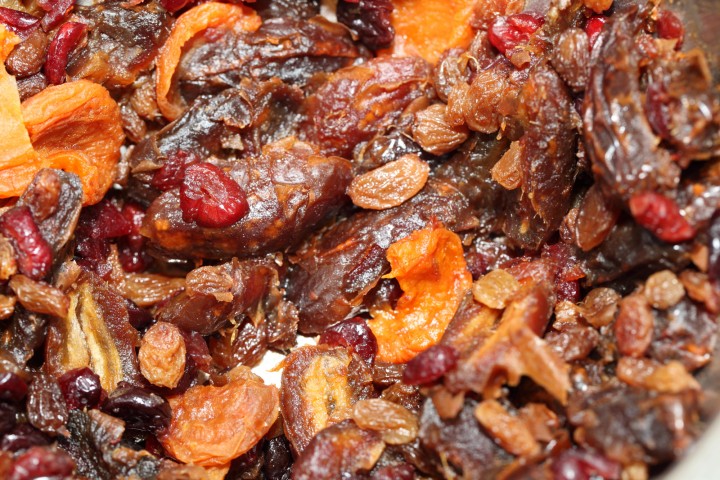
Soak fruit version 1
200 g HOT water
50 g rum (optional)
150 g dried dades
100 g dried figs
50 g dried apricots
50 g dried sour cherries
50 g raisins
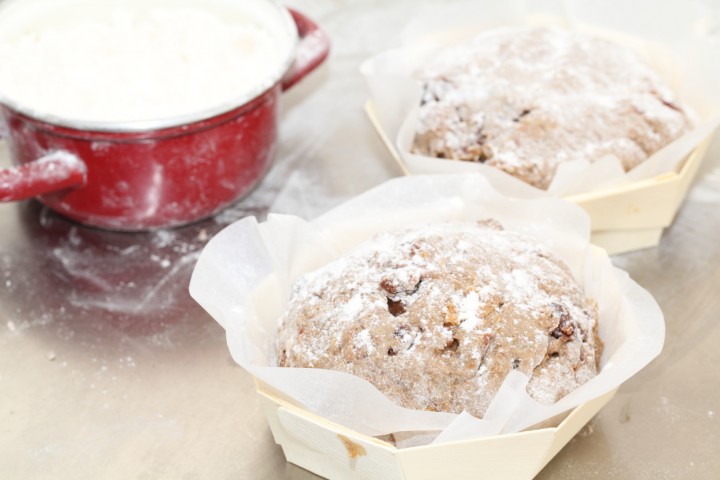
Soak fruit version 2
200 g HOT water
50 g rum
200 g dried pears
100 g dried sour cherries
100 g raisins
Ingredients
makes 2 loaves, about 530 g each
175 g whole rye flour
75 g bread flour
100 g rye sourdough starter (100% hydration)
4 g salt
4 g ground cinnamon
1 g ground cloves
200 g fruity water
400 g soaked mixed dried fruit
100 g nuts (combination of walnuts, pecans, almonds)
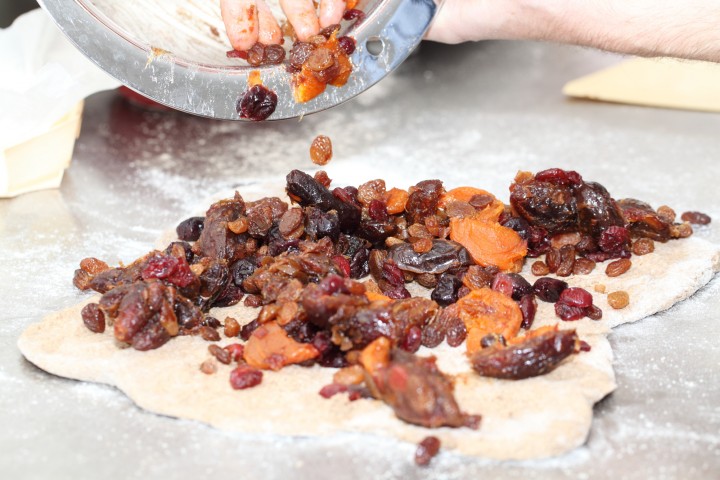
Day 1
Preparing the fruit
Wash your dried fruit and leave it to soak in hot water for one hour. We add about 50 grams of rum to the hot water, which is very nice, but you can replace the rum with water of course. Strain and keep the fruity liquid so you can use this flavored water in the recipe! Cover the bowl with cling film and leave the fruit to absorb the remaining moisture overnight so the fruit will be moist but not wet when you use it the following day. You can decide for yourself if you want to cut the fruit in pieces. We do not do this, because when the loaf is ready we cut thin slices from it and the fruit and nuts get sliced anyway, plus this way it looks more appealing to us.
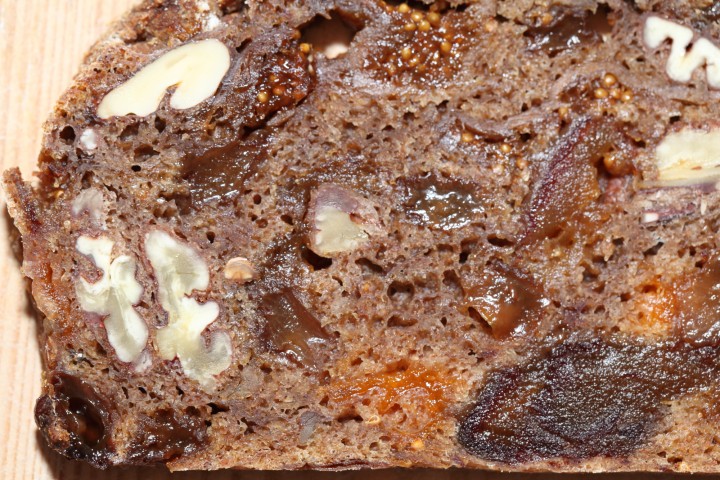
Day 2
Making the dough
The whole process on this day will take over 9 hours, so it is wise to plan and maybe start early.
Weigh the fruity water from the soaked fruits and add some more water so you will have the right amount of water for the dough (200 grams). In the bowl of your standing mixer, combine rye flour, bread flour, sourdough starter, salt, spices and the fruit water to your dough and mix for 1 minute, until everything comes together (of course you can also do this by hand). Cover and leave to rest for 1 hour.
Now knead the dough for 5 minutes (10 by hand) until you have a smooth and somewhat sticky dough (it will cling to the bottom of the bowl). Because of the large amount of rye flour the dough will feel more like a paste than a regular bread dough. Again cover and leave to rest for 1 hour.
Take the dough out of the bowl and press it into a flat rectangle. Distribute the soaked fruit and the nuts evenly across the dough. Roll up the dough and pinch and mold the dough so all the fruit and nuts are well distributed. Cover and leave to rest for 3 hours.
Divide the dough in two equal pieces and shape into balls or oval shapes if you prefer. Place the balls onto a tray covered with baking paper, or in bakeable wooden baskets like we did. Cover the loaves and leave for their final proof. This will take about 3 hours, depending on the temperature of the room and dough.
Preheat your oven to 200 ºC / 390 ºF. To get a nice crust, try to create some steam in your oven by putting a small metal baking tray on your oven floor when you preheat the oven and pouring in half a cup of hot water immediately after putting the bread in the oven. Release some steam by setting your oven door ajar (perhaps with the help of a wooden spoon or oven mitt) 5 minutes before the bread is ready.
After placing the breads in the oven turn the oven down to 170 ºC / 340 ºF (starting higher and then turning down, is done because by opening the oven door and adding the steam you may loose heat very quickly).
After 55 minutes of baking your loaves are ready. Place them on a rack to cool. Store the bread in a paper bag after cooling and leave to set and ripen for about 12 hours before slicing. This way it will be easier to slice and the taste will have improved further.
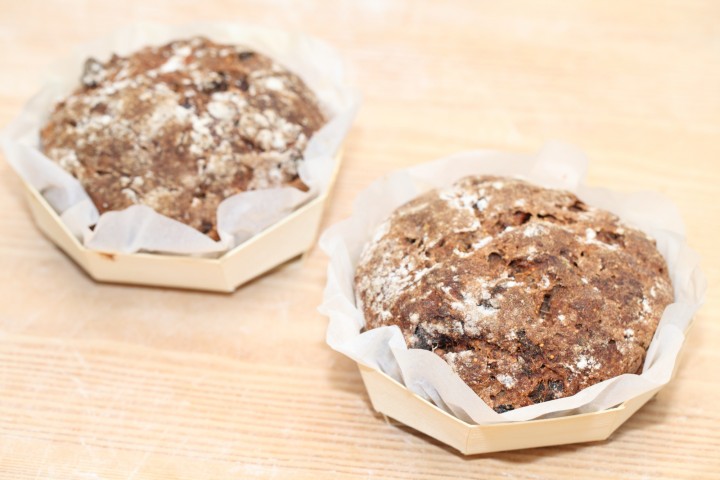
Fruit and nuts loaf time table
Day 1
Evening: Wash, soak and strain the dried fruit
Leave for 12 hours till next morning
Day 2
00:00 – Combine dough ingredients and knead for 1 minute
60 minutes rest
01:05 – Knead for 5 minutes
60 minutes rest
02:15 – Add filling to dough
3 hours rest
05:15 – Shape into two balls
3 hours final proof
08:15 – Bake for 55 minutes
09:10 – Ready and let cool




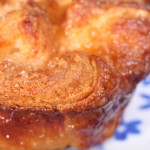
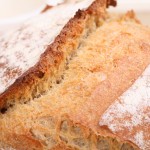
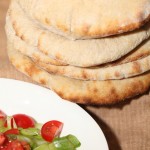
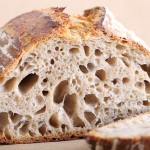
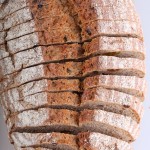
Ron Charles Burn says
Love your recipe..will try it next. I have been making a traditional one with Pear, figs, Prunes, sultanas & walnuts (no rum) . Yesterday i made one with Dried mango, bananas, apricots, ginger & pears. Used roasted Almonds & Coconut sugar. Fabulous.
Roberto says
Hi Marieke/Ed,
It looks dangerously delicious! I’ll have to make an attempt! Two questions:
To incorporate the fruit I just enclose it with the dough, after which the fermenting and proofing processes will “tie” everything together as a bread? Do I understand that right? Check.
Would you recommend me to use 14 cm stainless mixing bowls as “bannetons?” My next step in size would be 20 cm round, true, bannetons, but that’s much bigger – I am afraid the bread will spread out too much.
Thanks for sharing your connoisseur baking-knowledge. Your 3 stage 70% rye raisin bread is phenomenal!
Weekend Bakers says
Hello Roberto,
Thank you very much for your comment and for also liking the 3 stage rye bread :).
The answer to your first question, yes you are right. You distribute the fruit on the rectangle of dough, roll it up and then pinch the fruit into the dough. It is a bit fumbly but after the 3 hours resting it is already beginning to make more sense. You just have to do it and keep your eye on the end result which is a lovely loaf chock-full with fruit and nuts.
The second item on your list:
We use a Ø 14 x 4,5 cm bakeable basket in which we also proof the loafs, so we would go for the one that comes closest to that size.
Hope it will be good and you will enjoy making the loafs,
Ed & Marieke
Roberto says
Great, thanks for answering. I really do appreciate! I’m gonna give it a go 🙂
Darryl Alder says
Is the listed ingredient “150 g dried dates” actually dried dates? BTW I made this with just Kletzen last year and we did NOT like it much.
Weekend Bakers says
Hello Darryl,
Yes we use dried dates and the 150 grams is correct. The combination of the fruits we use will yield a much more interesting taste profile we think. Maybe you want to try our recipe as described some time?!
Olga Appelo says
Kan bij dit brood de tweede rijs ook in de koelkast?
Mira says
Fantastic! Thank you so much, it was very much appreciated by the whole family! Hearty regards, Mira from Belgium
Weekend Bakers says
Much appreciated Mira. Thank you for trying this recipe that is close to our heart and so glad you could enjoy it with your family.
Stay safe and keep on baking,
Ed & Marieke
WKB
Margot says
Hello. This looks so good and I’m going to try this weekend. Can I use my regular white sourdough starter or does it have to be a rye starter? Thanks!
Weekend Bakers says
Hello Margot,
You can use your own starter culture, no problem. Hope it will be great!
Margot says
Fantastic! Thank you.. I’ll let you know how I go 🙂
Margot says
Hello. It almost all went according to your description 🙂
However, the dough hardly rise at all in the second proofing (it doubled after the first proof). I poked the dough after 4 hrs during the 2nd rise and it left a dent so I baked it. It didn’t rise either during baking. Is this normal?
The bread tasted nice though! Very dense and fruity. Great with a cup of tea.
Thanks again for sharing this recipe :))
-Margot
Weekend Bakers says
Thanks for sharing your experience Margot. Yes, it is different with rye and the lack of gluten in rye also means it is harder to judge the proofing stages. As you can judge from the pictures the bread is denser and pretty much filled to capacity with the fruit. There is also not much of an oven spring like you would see with some loaves based on wheat. So this is very different but nice like you said. Intense and full of fruity flavor.
Rebecca says
Hi Marieke and Ed,
I’ve been wanting to try this recipe for a while, and have finally figured out when to plan it in… but have a few (possibly very stupid) questions before I start:
1) Shaping is still my biggest challenge. In the absense of bakeable baskets (which are no longer in your shop?), how tightly should I be shaping the balls before placing them on the baking sheet? I notice you don’t do pre-shaping and shaping (presumably because there’s not much gluten to develop), does the dough not spread?
2) I have a couple of American-sized loaf pans (about 23 x 13 cm), which works out to about the same surface area as 15 cm rounds. Given my aforementioned shaping issues, would you recommend using the loaf pans?
3) You don’t mention anything about pre-heating a baking stone, do these just get baked on a baking sheet without pizza/bread stone?
Thanks in advance!
Rebecca
Weekend Bakers says
Hi Rebecca,
Yes, you are right, the baskets are not in our shop at the moment or in the near future, but that is no problem and should not keep you from baking the loafs. Maybe you can indeed be creative with other molds and baking paper.
But it should be no problem to bake them without molds, they normally will not spread. The shaping is more like molding clay almost. You are right, it works and feels different than your average wheat dough.
There is no need to bake these loaves on a baking stone, you can use a baking sheet or place your loaf pans on a rack or tray. The oven temp and time are the important factors for a good result with this fruit filled loaf.
Hope it will be great!
Rebecca says
Thanks! Baked on a sheet, no spread. My rye starter was a bit sluggish, I suspect I should have given it longer to ripen/rise. So they came out very, very dense, but quite nice.
Weekend Bakers says
Hi Rebecca,
Yes, they all act different. Always more important to take the time needed than to exactly stick to the indicated proofing times with sourdough. Also if possible measure the temperature of your dough with a probe thermometer and transfer the dough to slightly warmer surroundings (You can use your oven as a proofing cabinet, ever so carefully warmed up to around 25 to 27 Celsius).
Gerlinde van den Bos says
Hi there, in the process of making this bread. Am I right that the dough does not really rises in the first 2 hours.
How big is the 2 breads? Is it pie size?
I’ve got the feeling I’m doing something wrong, there was no way I could put all the fruits and nuts in the loaf, but I’m making ice cream with the leftovers, so no harm done.
Thanks,
Gerlinde
Weekend Bakers says
Hello Gerlinde,
Yes, because of the use of rye flour and the amount of filling, the rise is there of course, but not very noticeable, like you would see in a standard loaf. The size of the molds we use is 15cm in diameter.
In this loaf there’s more filling than flour, so, as you can see in the picture, a lot needs to be incorporated in the dough, so it is a bit of a challenge, but if you stick with it, everything will come together, even though at first it seems a bit impossible.
Hope you will give it another try.
Seasons greetings and happy baking,
Ed & Marieke
Nathalie says
Can the loaves be baked in cast iron pot? This is how I bake my regular sourdough bread but at a much higher temperature?
Weekend Bakers says
Hello Nathalie,
We must admit we have never baked this recipe in a cast iron pot. If you want to try it, we would advice not to go as high as with your sourdough, because of the high fruit content. This might also stick to your pan, so lining it with baking paper would be an idea too.
Good luck with it!
Nathalie says
Thankyou I did do the loaves in the cast iron pots at about 400 but this time I’m going to go with baking in a pan in lower temp. The loaves were absolutely lovely and disappeared very quickly at thanksgiving gathering. I did cut them very thinly and served with cheese. I have 8 more fermenting right now!!!!!!! Thank you your recipes are beautiful and I am enjoying making them
Weekend Bakers says
Hi Nathalie,
Absolutely great to read your excellent feedback, thank you so much and happy holiday baking and sharing!
Greetings from Holland,
Ed & Marieke
Mary Pearlman says
I am a beginner baking by formula. Is it correct that you are measuring all ingredients by weight? Including water? I’m sorry to be so stupid, but I’m an American, and my mother never had a kitchen scale – only measuring cups and spoons. Thank you so much.
Mary
Weekend Bakers says
Hello Mary,
Yes that is correct, we also weigh the water. We weigh everything, it is the way to get consistent baking results. Measuring by volume can seem quick and easy but tests have shown that variations in amounts are considerable. Baking is an exact science and measuring with cups and spoons can lead you to diverge by as much as 10 to 20%. Also when weighing small amounts of yeast and salt we find our scales of great value.
We want to applaud you for going in this direction and hope it will proof to be easy and comfortable for you in no time.
Happy baking!
Marieke & Ed
Durriya Iyer says
I so love d idea of this bread. In absence of rye flour, cud I use whole wheat flour n white bread flour in 1:1 proportion?
Weekend Bakers says
Hello Durriya,
Yes, that is no problem, it will be different but also good we are sure, although we have never tried it with anything but rye flour. We think you might use a bit less of the fruity water, because of the difference in absorption. But you really need to see the flour in this loaf as a way to bind the fruit together. In that way it is very different from a regular loaf of bread.
Good luck with it!
Rik says
Hi Ed and Marieke,
These loafs look very appealing.
Can you tell me how the temperatures and times would be when baking with a Rofco oven?
Thanks in advance for your reply.
Best regards,
Rik
Weekend Bakers says
Hi Rik, we bake them at 200C and turn down the oven to 50C when we bread has reach a nice color. This way it will cook all the through without getting to brown. The times on 200C depends on your Rofco type and the number of loafs loaded.
Becky says
This looks wonderful! How much sourdough culture should be used to make the sourdough starter?
Weekend Bakers says
Hello Becky,
What we mean is you add 100 grams of active sourdough to this recipe and this mixture consists of equal parts water and flour (which is 100% hydration). So if you have a jar with your own sourdough culture you can just add this to this recipe. If your own culture contains less or more water you can compensate a bit by adding more or less (fruity in this case) water to the total recipe. You can also check out how we make our own rye sourdough starter culture here: www.weekendbakery.com/posts…asy-steps/
Hope this helps,
Ed & Marieke
Rianne says
Hello Ed and Marieke,
Maybe I missed it somewhere but would you be so kind to explain to me the differences in the mentioned sour dough hydration percentages in the different recipes? (Or lead me to the right place where you perhaps already mentioned it before?). I have a really good starter in the fridge as a basic. I presume that’s ok to work with?
Weekend Bakers says
Hoi Rianne
Wij werken in veel van onze recepten met voordeeg (denk aan poolish en biga, combinaties van meel, water en desem) dat we de avond voor de bakdag bereiden. We gebruiken daarbij maar 15-20 gram desem per brood. Met deze kleine hoeveelheid desem maak je een volledig actief voordeeg gedurende de nacht. Dit gebruik je vervolgens in het uiteindelijke deeg. Op deze manier onderhoud je dus een klein potje desem en krijg je toch je echte zuurdesembrood. Omdat je een klein beetje gebruikt van het desem maakt het ook niet zoveel uit wat precies de verhouding / hydratatie percentage is van je desem, omdat het maar een een paar gram water meer of minder gaat op het totale recept dat je uiteindelijk toevoegt. (Veel recepten op internet gaan ervan uit dat je bijvoorbeeld 250 tot 500 g desem maand in maand uit moet onderhouden, wat ervoor zorgt dat je bij weinig bakken heel veel (kostbaar) meel moet weggooien. Onze methode met het poolish / voordeeg stapje zorgt ervoor dat je een klein desem kan onderhouden, toch veel kunt bakken en heel weinig hoeft weg te gooien. Veel recepten, die van professionele bakkers afkomstig zijn, houden geen rekening met de behoeftes van de thuisbakker om kleinere desems aan te houden, want zij zijn gewend iedere dag grotere hoeveelheden te gebruiken).
Dus als je onze recepten volgt kun je gewoon je eigen desem gebruiken en hopelijk met goed resultaat.
Jan-Pieter says
I have successfully tried a number of your recipes and I now would love to make your variant of kletzenbrot, however I fail to find dried sour cherries. In itself not a major problem as I will be replacing them with dried cranberries which have a similar refreshing sour and sweet flavour. But I just wondered, where do you get your dried sour cherries from?
Jan-Pieter
Helvoirt – Netherlands
Weekend Bakers says
Hello Jan-Pieter, you can indeed use any kind of dried fruit with this recipe. We buy our dried sour cherries at www.jangotje.nl/ look under Gedroogde zuidvruchten, Bessen. Happy baking!
elena says
Hello!
Does it work with yeast instead of sourdough?
If yes, please let me know the measure 🙂
Tx a lot!
Weekend Bakers says
Hello Elena, no problem to use yeast instead of sourdough starter. Just add about 5g of instant dry yeast to the dough. You also need to add an extra of 50g water and 50g of whole rye flour to compensate for the 100g of sourdough rye starter. Happy baking!